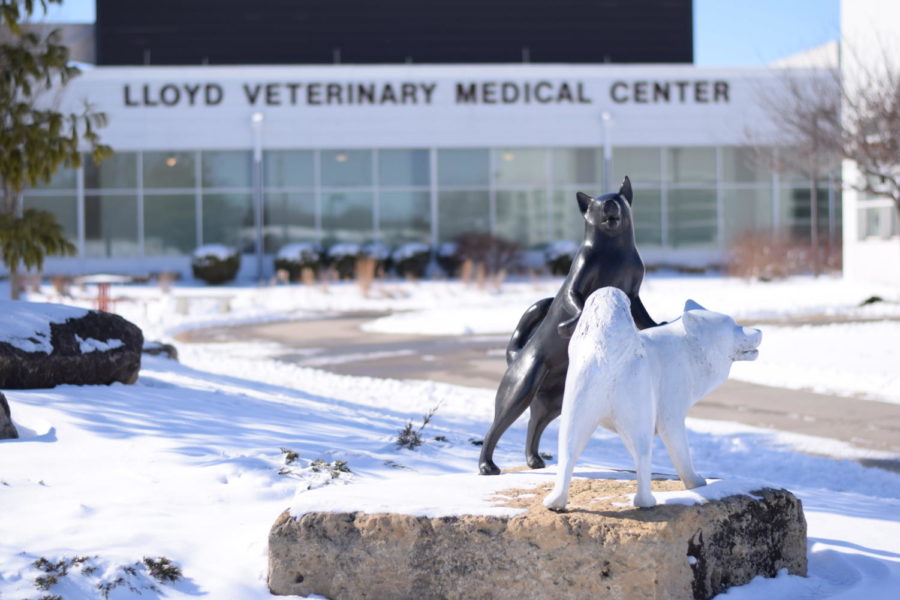‘We just didn’t eat’: VetMed students speak out about working conditions
The Lloyd Veterinary Medical Center is a teaching hospital used to expose students to clinical environments as well as treat animals. The hospital is primarily made up of the Hixson-Lied Small Animal Hospital and the Equine and Farm Animal Hospital.
Madison Esker, a year four veterinary medicine student, said during a rotation in the large animal ICU she found herself constantly working from 5:30 a.m. to midnight, violating a policy that requires students to be allowed a minimum eight hour rest period after spending 18 out of 24 hours in the clinics.
Students say the fourth year consists primarily of duties within Iowa State’s teaching hospital, whereas veterinary students spend the first three years of their curriculum in typical classroom settings. During their fourth year, students’ clinical duties are made up of two-week rotations in which they receive and treat patients. On top of that, many students have in-house duties during which they provide after-hours service and care.
Many students experience similarly long days when assigned to the college’s more strenuous rotations. Not all rotations are so taxing, but many students have pointed out that the high workload takes a toll on their well-being.
To prevent students from being over-scheduled and overworked, the university implemented a duty-hours policy in 2019. The policy limits the time a student is required to spend in the clinics to 80 hours a week and requires students to take a day away from clinical responsibilities every week, among other guidelines.
Esker said she experienced a number of violations in the large animal clinic. In one rotation, which took place shortly after Christmas, Esker said she and her peers were scheduled to work every day of the week and weekend, despite the duty-hours policy requiring students to have at least one in seven days away from clinical duties.
Senior Associate Dean in Veterinary Medicine Administration Jared Danielson oversees the duty hours policy and addresses violations of it. He said when students look ahead in their schedule and identify violations of the policy before they actually go through the rotation, he is able to resolve the schedule and prevent violations from taking place.
Danielson said if a student knows they have hit their 80-hour limit or have experienced other policy violations, they can go home, but said students often make the decision to stay to complete the day’s work.
“It’s hard, but they also see that if they leave, it’s going to be harder,” Danielson said. “So even though they could go to the faculty member and say ‘I hit my 80 hours,’ they don’t because they’re part of that team, and they see that they’re needed.”
He said he prefers when students are looking ahead and bring scheduling issues to his attention before working through them. Students sometimes instead report violations of the policy after they have occurred, in which case Danielson said there is not much he can do.
Danielson said scheduling the rotations in the clinic and assuring that every rotation is adequately staffed can be challenging. He said there are a lot of moving parts, and that it can get very complex.
“We’re there 95% of the time, but it can be really hard when we’re not,” Danielson said.
Esker said during a rotation in the large animal ICU she and her peers found themselves needing to arrive at the clinics around 5:30 a.m. to be ready for 8 a.m. rounds.
“So essentially, if I’m there at 5:30 a.m. and I work through the day, and to midnight, I’ve been there for more than 18 hours,” Esker said. “And now I have to be back at 5:30 a.m., which is five-and-a-half hours of rest– not eight.”
Esker said five-and-a-half hours of rest does not equate to five-and-a-half hours of sleep. She said she still would like to eat, do laundry and fulfill other necessities.
Brittany Albers-O’Brien, another year four veterinary medicine student, reported one rotation in which she worked 90 hours both weeks without having a day off. She also said there were instances of canceling or missing medical appointments in order to not miss any time in the clinics.
Albers-O’Brien said while students are supposed to receive 30 minutes for a lunch break, on some of her rotations, she never received one lunch break.
“Yeah, I lost 15 pounds on my month of ICU,” Albers-O’Brien said. “We just didn’t eat; you didn’t have time to eat.”
Albers-O’Brien said not all rotations make it so hard to get a meal in, with some rotations even allowing students to leave the clinic for lunch breaks of up to an hour.
Brandon Garrison, another year four veterinary medicine student, stated in an email with the Daily that the requirement that students get one day off within every seven is “a joke.” He stated he had a stint of 20 days without a day off from clinical duties, as well as several incidents of working more than seven.
“Twenty days straight of 10-12 hour days wears on you– especially as a student who is being bombarded with information, constant questioning and is mentally and physically exhausted,” Garrison stated. “Many struggle to keep their composure. Even more struggle to maintain the care of their patients while battling exhaustion and constant stress.”
Garrison described one instance in which he was the only student on a two-week-long canine rehabilitation rotation. He stated the rotation typically includes a minimum of two students but usually includes three or four.
He stated during the first week of the two-week rotation, not even the canine rehabilitation specialist was present as he was on vacation, leaving all the responsibilities of the clinic on himself and a canine technician. During the second week, Garrison stated the rehab specialist returned, but the technician then had his own absence.
“At first, I thought it was no big deal as canine rehab has a reputation of being a pretty chill and laid-back rotation,” Garrison stated in an email to the Daily. “It quickly became apparent that I was going to be used as a workhorse.”
Through the rotation, Garrison stated he was responsible for all of the patient care. In the evenings, Garrison stated he would have to return to the clinic to take patients out, medicate them, feed them, update their records and call owners with updates. During the weekends, he stated he would make three separate trips to the clinic throughout the day to fulfill similar responsibilities.
Garrison stated while he was not happy with the way the rotation went, he placed no fault on the clinician and technician he worked with. He stated throughout the rotation, they were sympathetic and worked to make the best of the situation.
Danielson said large quantities of patients, emergency situations and absences from rotations could put a larger workload on people on duty in the clinics. He said sometimes students will get sick or be unable to take part in a rotation to which they’ve been assigned.
“Every once in a while we have a situation where we just have our services overwhelmed by a sort of perfect storm of circumstances,” Danielson said.
Danielson said another issue that occasionally pops up is students can drop some rotations if they are not required for them to graduate. He said sometimes the clinic sets up a rotation so that it has enough students until a student drops off the rotation. Danielson said that would usually lead to the students and faculty remaining on the rotation having a tough two weeks.
“Now you had two students who are trying to do what three students would typically do,” Danielson said. “We do rely on our students to do work in the clinic. They’re a critical part of the health care team in the clinic.”
He said there are even times when it is not a student that gets sick or drops a rotation, but a faculty member or technician who gets sick or even quits.
Esker also said students are also asked to work certain hours and do certain tasks without consideration for the student’s time or the actual needs of the clinic.
“I sit there and stare at the wall awake when I could be sleeping because there’s so little to do,” Esker said. “They just have us there because they’re not paying us and it doesn’t matter to them.”
Danielson said the clinics try to avoid scheduling students for unnecessary shifts, but occasionally it does occur.
“A student reported it this year, and in that case, I reached out to the chair of the department and said, ‘Hey, this is happening,’” Danielson said. “And usually if faculty are aware of it, then they make adjustments to those kinds of things.”
Esker said the policy is set up in a way that its enforcement falls on the students to carry out.
“I emailed the [associate] dean when I was on this rotation to tell him about the overt lack of following of the policy,” Esker said. “The thing is, I believe that it’s a staffing issue. I don’t want to take it out on the clinicians, I don’t want to take it out on my patients, but I do believe change needs to be made.”
Esker said there had been times when the long work days and lack of sleep got in the way of completing readings and homework. Not only did she say she would sacrifice her educational duties because of the long hours at the clinics, but also her personal obligations to herself.
“I’m choosing to eat cookies instead of cooking, I’m eating whatever random food is in my house,” Esker said. “I don’t have time to go to the grocery store. You’re never not at school during the hours that anything is open.”
Esker said not every rotation is as busy as others, but even the lighter rotations are not ideal.
“If you were at a job and they were treating you like this, you could just go get a different job,” Esker said. “But as fourth-year vet students, you can’t really transfer, you can’t just say ‘screw you, I’m not going to do it’ because at this point, we’re six figures plus in debt and graduation is essentially required for life.”
Brennan Goodman, a year four veterinary medicine student, described experiences of veterinary students in various rotations in an email exchange with the Daily.
“I have only experienced a few violations except when I was on the ICU rotation in July-August,” Goodman stated. “I would eat my lunch while walking the hallways to get back there to help out. I lost 10 lbs in a month on that rotation.”
Goodman stated the duty-hours policy is written in a way that leaves the lunch policy up to students to organize, yet he stated students are not going to speak up for themselves when there is an emphasis on patient care, not student care.
“You feel guilty going on break on your 12-hour shift when there’s so much to do, but breaks also are an important part of staying mentally sharp and avoid making mistakes,” Goodman stated.
Goodman stated although there is potential to get schedules corrected to align with the duty-hours policy, students often just decide to roll with the punches. He stated because rotations only span two weeks and students only spend a year in the rotations, many students opt not to speak out.
“We’re hard workers in general, we care a lot about our patients, [but] we’re new and vulnerable,” Goodman stated. “There’s the thought of a poor grade if someone speaks up.”
Albers-O’Brien said going through the fourth year of a veterinary medicine degree is a taxing situation in general, but when paired with other health concerns, it begins to take a serious toll on students.
“It started to affect not only my physical health because I wasn’t getting enough sleep, but really my mental health too,” Albers-O’Brien said. “And I mean, a lot of us already have issues with depression and anxiety and other things, so it kind of sucks when you have the added pressure at this place that’s the only place you go all day long.”

Albers-O’Brien said it sometimes feels like she’s treated as much like an employee as a student. She said it is upsetting to think that she pays more than $20,000 per semester to be put to work on tasks to keep the clinics running, like cleaning up after patients and staying late to help with patient care.
“Sometimes they don’t even let us draw blood or place catheters,” Albers-O’Brien said. “It depends on the rotation and the clinician, but there’s been some of rotations where I didn’t do a single hands-on thing that made me feel any bit closer to being a doctor.”
Danielson said much of the patient care and bookkeeping are important aspects of the daily duties of a veterinarian. He said from the faculty perspective, many of these duties are critical for learning.
“What nobody wants to happen is for students to be just so tired, and have so much of a workload that they can’t think and that they can’t learn to function as a veterinarian,” Danielson said. “And absolutely, that’s not what we want.”
Albers-O’Brien said the pressures of working in the clinic and taking care of patients make it hard for students to take time for themselves despite the emphasis placed on self-care during the first three years of the veterinary program.
Garrison stated that overall his experience in the small animal hospital has been OK, but some rotations are much better in terms of education and experience than others.
“Clinical year is where we are supposed to practice our roles as clinicians,” Garrison stated. “We are supposed to get hands-on experience and gain clinical knowledge. We are supposed to be bringing the last several years of our education together to form diagnoses and treatment plans, we are supposed to be doctors in training.”
Garrison stated some rotations work hard at allowing students to step into the role of being a doctor while others simply have students carry out the “grunt work,” which he stated includes hours of paperwork, calling owners with appointment reminders and after-hours patient care.
“Some days it seems we do everything but be a doctor,” Garrison stated.
Garrison stated it is frustrating that the importance of making time for ones’ self and maintaining mental health is stressed through the first three years of veterinary school, only to be left behind in students’ fourth year.
He stated he has developed a strong bond with his peers, though the bond is more similar to that between “trauma victims” than colleagues.
Danielson said he is grateful that students can recognize the emphasis the university puts on mental health during the first three years of the veterinary curriculum, adding that the first three years of the veterinary medicine program are also quite demanding.
“We’re doing our best to make it as wellness-focused an experience as we can,” Danielson said. “And it’s a very inherently demanding profession, which we also try to communicate. And we’re trying to get better at both of those things, but that’s what they discover in the fourth year often.”
Danielson said staff members and faculty working in the clinic have similarly high workloads.
“What students don’t see is that the full faculty experience is much more than the time that they’re side by side, elbow to elbow [with the student] in a clinical setting,” Danielson said. “Faculty are also working individually with other learners, they’re answering email from students, they’re interacting by phone with referring veterinarians. It’s an awful lot that they’re managing, and they try when they’re with a student to be present with that student.”
Danielson said he is amazed by the work many of the veterinary professors do. He said he is consistently impressed with their ability to manage their various responsibilities and keep the clinic running.
“The faculty are the ones who are communicating with grieving clients, and they’re the ones who people are complaining to,” Danielson said. “They always just look like they just have everything under control, but they’ve usually got a variety of challenges just under the surface that the student isn’t aware of.”
Danielson said five years ago, the college did not have a duty hours policy. The expectation was that students would come in and work until the work was done. He said the creation of the current duty hours policy came out of concern for the types of situations students have brought up.
Danielson said an alternative that would ensure a more manageable workload for students would require limiting the number of patients the clinic admits. He said nobody wants to limit the amount of care the clinics are able to provide.
“This is a patient that needs the care, so we’re going to do what we have to do to provide it,” Danielson said. “That’s really the mentality of all of them– the faculty and the house officers and the students– really that’s what they’re all there for, but it still sometimes makes for a hard couple weeks.”
In regard to paying students for services in the clinic, Danielson said there is no argument on whether or not students bring value to the clinic.
“We’re grateful for our awesome students,” Danielson said. “However, part of the nature of a teaching hospital is that because our clinical faculty have students with them, the hospital moves at a much slower pace than it would if it were just a referral hospital.”
Danielson said it costs Iowa State more to educate students in the clinical setting than it would to simply operate as a typical hospital. He said most referral hospitals see many more patients much more quickly than at Iowa State’s teaching hospital. He said students are the clinics’ primary clients in that regard.
“What their tuition is getting them is access to that environment with those faculty who are teaching them and the other instructional staff who are helping them to learn at a speed that allows them to learn, because as fast as they feel like it is, it’s not compared to what it will be when they’re out and in the real world,” Danielson said.
Your donation will support the student journalists of the Iowa State Daily. Your contribution will allow us to purchase equipment, send our student journalists to conferences and off-set their cost of living so they can continue to do best-in-the-nation work at the Iowa State Daily.











Z | Apr 2, 2024 at 6:22 pm
I’m a 4th year who is about to become a Small Animal Rotating Intern at Iowa State University. My question is:
What can I, as an Intern, do to improve the student experience? How can I help the students as a House Officer?
As a 4th year at an institution that is equally as exploitative and grueling, I can empathize and I want to do everything in my power to make sure my future students will NOT have the same clinical year experience that I did.
PennVet Fourth Year | May 27, 2023 at 3:11 am
If someone came up to me and said “I work 80 hours a week” my reaction would be “Wow, that’s insane! How do you work so many hours? WHY do you work so many hours?”. I don’t think anyone would call someone working 80 hours per week lazy.
But when students say “Hey, can we get a limit of 80 hours per week? We’re willing to work 80 hours a week but if we have to work more we cannot take care of ourselves or our patients,” suddenly they get called “lazy” and “entitled” and “weak”.
And it’s not just Iowa State. I just started my fourth year at PennVet and the hours are equally insane. I know multiple students on multiple services who are at the hospital from 5:30 am to midnight, then are back again at 5:30 the next morning. I regularly bump into my classmates eating for the first time that day at 3, 5, 7, and even 10 pm. I got lucky and started with a few chill rotations, but by chill, I mean 7 am to 7 pm Mon-Fri + on-call hours (I got called in for 10 hours last Sunday).
We just sent a letter to the administrators protesting the working conditions. I have yet to talk to a single classmate who disagrees with the letter, yet only a few of us signed it because everyone is terrified of repercussions. They’re scared of failing a rotation or being denied letters of recommendation if they speak up about how they are being mistreated.
I seriously doubt anything will come of the letter. Penn’s response to all of our suggestions for improvement has been “That’s nice, thank you so much for sharing that idea, but no”. But if we don’t try, nothing will change.
Penn puts such an emphasis on taking care of our mental health, but it’s always on our shoulders. We should get 8 hours of sleep. We need to go to doctor’s appointments. We need to make sure we don’t get burnt out. But when we say “Hey, we can’t get 8 hours of sleep because you require us to work 18 hours a day” or “I can’t go to doctors’ appointments because I’m not allowed to leave for them” or “We have too many cases and are doing too much grunt work and it’s burning us out” the response is “Oh well, figure it out”.
I’ve already lost a friend and fellow vet student to suicide. I’m terrified that this year I’m going to lose more. No one is asking for a 4-day work week. We just want to be treated like human beings. We want half an hour a day to eat lunch and 8 hours of sleep. It’s insane that some people thing that’s too much to ask.
Andrew | Apr 6, 2024 at 3:37 pm
Sounds a lot like a clinic I worked at, followed by another…it’s the way the business is..if anything they are truly preparing you for how life is at a vet clinic
MarissaDVM | Apr 1, 2023 at 6:09 pm
It is up to students to report their rotations- if I had done this when I went to school you KNOW I would have been persecuted. Of course they aren’t reporting it, they’re essentially slave labor. Wake up and realize that vet schools need more support staff (trained techs, assistants, etc) so that students can be LEARNING, not doing grunt work. When I was in school we had nurses going on vacation from the ICU every week during summer. This meant that students got called in every night at 2 am to help with treatments, then had to be back at 6 am. There was always a student in the hospital for “walk-bys” in the large animal ward- just walking past them to make sure they were ok, refilling fluids, helping give meds. THIS IS NOT LEARNING. This could have been fixed by simply hiring more techs or getting current nurses to cover extra shifts. The abuse veterinary students go through is ridiculous, considering I paid $20k a semester to do it.
Trina | Mar 31, 2023 at 7:48 am
Unfortunately, these students are not just “weak” or “don’t want to work” like some in the comments seem to believe. You didn’t walk in their shoes. I graduated from ISU-CVM in 2020 and this is how it was. I can honestly say that I learned minimal in my fourth year rotations, because I had to do the behind the scenes “grunt work” and didn’t have a chance to write notes down, review what I’m seeing and learning, or look new things up. It was too much rushing and exhaustion and not enough time to process. They rarely allowed us to do actual veterinarian tasks either. Not all rotations, but many. Only on rotations away from the school did I really have a good environment to soak in information, write notes on it, review it, and have something useful to take into my career. I use THOSE notes weekly. They also eradicated their exotics program that year (I work exclusively with exotics in practice). Needless to say ISU will never get another penny from me nor will I recommend students to them.
jon smith | Mar 18, 2023 at 5:26 am
Follow the money
Jon Smith | Mar 16, 2023 at 8:47 am
Need to fire people. Look at the books. Are the staff not doing their jobs or just collecting pay check. Do not take anything at face value. Have independant auditor come in and find out where money is going and why you pay so much to clean kennels.
S | Mar 3, 2023 at 7:38 pm
Exact same thing happens at TAMU, but there isn’t even a policy in place. Danielson is giving a lot of excuses for their terrible treatment to student.s
G | Feb 27, 2023 at 4:41 pm
Absolutely disgusting that the school shifts the burden of responsibility onto students. There is a clear power imbalance in that structure, and the school is banking on students not speaking up. Disgusting! You should be ashamed of yourself Iowa State.
K | Mar 4, 2023 at 3:33 pm
This is how most issues get dealt with here. If students complain, we are given a roundabout explanation that shifts the blame onto us.
It’s happens constantly. We recently lost 20+ students (I think nearly 18 of them came from the 1st year class). When addressed the school told students to check on our peers. If 10 percent of a class is failing.. I think it speaks more of the program/professor then the students. No other US school loses this many students.
WY | Jun 5, 2023 at 12:31 pm
K, I was one of those students; sadly. I believe 27% of the freshman class has been dismissed or did not come back after break(s). This program is insanely difficult and I have noticed a significant decline in mental health across the board for classes. Something needs to change and I agree that the curriculum and way professors teach need to be looked at first.
VM23 | Feb 26, 2023 at 12:24 am
The same events referenced in the article above happens at the Illinois Veterinary Teaching Hospital, and I bet most (if not all) the veterinary teaching hospitals in the country. I’m proud of my fellow 4th year vet students for speaking publicly about this. We are also trying to bring awareness and create change at IL VTH. We support and stand with you!!
-4th yr IL Vet Student
MarissaDVM | Apr 1, 2023 at 6:05 pm
2018 U of I grad, I felt like a slave in clinics. It was normal to work more than 80 hours a shift, 100% staff the isolation ward with students, and be in hospital 7 days a week for months on end. It gets better!! If I could do it over again, 90% of the time I would not. Vet school was awful, and clinical year was grueling, and we did not have any wellness support provided (as this was the beginning of us realizing the suicide epidemic). I had hoped it would get better with the new info we have, but it looks like it isn’t.
Meghan | Feb 25, 2023 at 8:54 pm
The EXACT same thing is happening at many other schools with the same response from the administration. Currently at Oklahoma State and it is atrocious
Sky | Feb 25, 2023 at 9:59 am
This is absolutely horrendous. Vet students aren’t there to be (over) full-time, non-paid servants for the vet school. This is meant to be a learning opportunity… not free, over-worked labor! If you know you have over-scheduling issues fix it! Don’t blame the students who are just trying to finish their rotations in order to graduate. They do not deserve to be treated like this.
“Danielson said an alternative that would ensure a more manageable workload for students would require limiting the number of patients the clinic admits. He said nobody wants to limit the amount of care the clinics are able to provide.” You should be ashamed of yourself. Trying to guilt trip students into working well over their limit of 80 hours a week. It is your fault that you do not hire more help when things get busy. Threatening the fact that you might not get to accept more patients in need of help in exchange for students risking their mental and physical health is sickening. You said it yourself, you are violating your own policy of how long students are actually allowed to work each week. You do NOT get to blame the students for this when you are threatening them and making them feel guilty for not working over their hourly limit.
Especially considering the rate of suicide within the veterinary field (vets are just about 2x as likely to commit suicide than the general population), you would think Iowa State would take better care to make sure the health of their students comes first.
I am sick. Iowa State do better. More people should be talking about this.
Joan Anderson | Feb 24, 2023 at 4:14 pm
Sounding like you need a 4th year & a 5th year to learn what you need and have a pace you can live with. Twice the students available to keep the hospital functioning and enough time to learn more than scoop the poop
Michele King | Feb 23, 2023 at 3:59 pm
Ffs. You can pack a lunch, you can pack a dinner. This is what happens when vet medicine meets Gen z. Good luck to all of us. There’s nothing wrong with having to work a little harder during vet school, these are the times when I remember learning so much about patient care. In the wee hours of the night when it was just me and them, I understood what they needed. This generation will never get that. This article frustrates me so much.
Toni | Feb 24, 2023 at 1:12 am
Oh Michelle.. talk about frustrating- your comment is just that! This millennial can’t wait for you to retire. Looking forward to the day where vet med is rid of all these hateful boomers.
Annabella | Feb 24, 2023 at 11:38 pm
What? That doesn’t mean that students shouldn’t be able to maintain a life outside of their clinical/schoolwork. Although vet school is meant to be rigorous, deeming “Generation Z’ers are just lazy” is ignoring the issue at hand and placing the blame on a random group of people. You’re very rude and disrespectful.
Nicole Joy | Feb 25, 2023 at 10:32 am
Hello Michele –
The comment that you made is the type of mentality that perpetuates the cycle of “I went through it so ‘they’ should go through it”. This article isn’t about complaining, it is about bringing awareness to mental health concerns that is making the veterinary profession sick. 4th years, interns, and residents are all STUDENTS, and regardless of the educational level, student mental, physical, and environmental health should always be the primary focus of a teacher, (which is what these clinicians and faculty members are in a veterinary teaching hospital).
Studies after studies have shown how burnout, fatigue, and mental health disorders decrease patient quality care, increase risk of medical error, decreases communication and cohesiveness within and between teams, and increases the risk of death by suicide. I agree that there should be a balance of student education through hands on learning and manual labor during the 4th year clinical rotation. However, the scales are constantly tipped in favor of manual labor because of everything outlined in the article above (low staff, lack of communication, unanticipated life events, etc). This, leads to further burnout, compassion fatigue, development of mental disorders, and death by suicide.
Deviating away from mental health, this stage in veterinary student education is the ONLY time to learn key veterinary skills that cannot be taught in a classroom. This is different from doing externships because students are at a stage in their education where they can now work intimately with the doctors in various speciality services (ie getting a “crash course” of each specialty). This cannot be achieved when the balance is tipped towards labor rather than student education. Key educational moments are missed and put MANY students at risk of not practicing at the same level of patient care they would have been when they graduate and start practicing.
I’d be happy to cite the research articles where my information is gathered if you would like to read more about this topic.
Bethany | Feb 25, 2023 at 4:56 pm
It also takes time to make and pack that lunch and dinner, packing doesn’t magically make the time for getting the groceries and cooking that food disappear.
Celeste Matthews | Feb 23, 2023 at 3:15 pm
I graduated from UGA College of Veterinary Medicine many years. It was hard. We stayed up all night sometimes. But what is being described here is downright criminal. I would not want my pet to be treated by a veterinary student that was tired, hungry, and depressed. It is bad for the patients. It is bad for the students. And I certainly will not be donating to this vet school that treats students worse than a Dickens work house slave. This is a total nightmare.
Jenna | Feb 26, 2023 at 8:05 pm
As a 2021 ISU graduate of the DVM program, I can wholeheartedly say that the term “workhorse” is relatable. I would be far more appreciative if I had been included in learning activities instead of being told, “No you can’t watch, we need you to do rounds again, etc.” countless times. The clinic was so short staffed, it was obvious I was needed. As many, we give up our own needs for our patients and so our fellow rotation-mates do not have to pick up any extra slack. But I will always hold a grudge for the many missed learning opportunities. That, and the plug being pulled on the exotics program.
All these crab apples who think we need to sacrifice ourselves day in and day out need to retire. Even my first year out was a walk in the park after year 4 during COVID. And I did it learning little to nothing from my 4th year. I WISH….did you read that – WISH I was lying. Maybe it’s you people who need to buck up. Try being a new doctor who was never once allowed to put in an IV catheter.
Michelle d Behrendt | Feb 23, 2023 at 9:17 am
Don’t become a veterinarian!!! Can’t remember the last time I turned off the animals and went home!! Been a veterinarian for over 30 years and still love it but missed many meals with family long nights into early mornings they r in the WRONG field
Cory | Feb 24, 2023 at 10:31 am
How on earth did you get a doctorate?
Jenna | Feb 26, 2023 at 8:25 pm
Am I missing the part where you missed meals, got only a couple hours of sleep….for 20 days straight…because you were on kennel duty?
Amo | Feb 23, 2023 at 8:46 am
NOW… imagine NOT having the university’s “rules” of restriction and you’re an ACTUAL employee?!
Also, imagine you are a licensed RVT and get paid SQUAT!
We’re CONSTANTLY understaffed, underappreciated and SEVERELY UNDER PAID!
Put your big girl panties on and deal with real world life!
It IS important to set those boundaries but once you clock in… work life takes over.
– signed RVT of 25 years!
Toni | Feb 24, 2023 at 1:05 am
The attitude that we suffer so you should suffer is exhausting. I’m sorry you’re paid terribly, the university is to blame or wherever you work. I’m sorry you are undervalued- as a former tech I totally have experienced this and I understand how challenging that can be. The problem with your statement is that you are telling students to just accept the circumstances. Why would we do that? So we can be like you in 25 years and feel overworked, under appreciated and underpaid? No thanks, I’ll work hard and also fight for better working conditions for students, techs and doctors.
Students like the ones mentioned in this article are going to be the reason why less techs will leave the field, because people like me and them will fight for ourselves and our coworkers. Im sorry that you haven’t had someone willing to do that for you, but don’t tear down students because you’re miserable.
Vic | Feb 26, 2023 at 10:08 am
It sucks that you’re being paid terribly; that also has NOTHING at all to do with this story or situation.
Vet students are paid *NOTHING AT ALL* so if you’re going to make it a competition about who’s work vs compensation balance is the most unfaif, you’re absolutely going to lose that one. Even if you got paid $5/hr as a tech- Vet students are PAYING to be there, while you’re being paid. You also have the freedom to leave and find employment elsewhere. Vet students can’t just quit or transfer schools with their 6-figure debt. Be for real, pls. -Signed someone pursuing human med who’s so fucking sick of how ridiculously hard Vet Med is being made, even compared to our training.
Jenna | Feb 26, 2023 at 8:31 pm
Ok but the article is literally about how the policy is a big joke. I feel for the employees, and they are a big reason I never attempted to leave despite this facade of a policy in place. The employees get paid and know their duties. They are higher up on the heirarchy than students. The students are told they will have opportunities to learn, pay $30,000 + a year and get stuck doing kennel work INSTEAD of partaking in learning opportunities.
Adam Andrews | Feb 22, 2023 at 10:45 pm
Just another group of entitled whiners who don’t want to work hard. Perfect examples of why the veterinary profession is rapidly going downhill and is no longer highly regarded by the public, as it once was. So happy that I am a retired veterinarian!!
VM4 | Feb 23, 2023 at 9:43 am
Wow! You are definitely what is wrong with the profession and I am thankful that you have retired, mostly so that other people aren’t given your “pep talk”. We work hard everyday and we deserve to be treated like human beings. Just because you had it hard, does not mean we should too. I think that may be why your mentality is so skewed.
John | Feb 23, 2023 at 10:37 am
Trust me Adam, we’re happy you’re retired too. This field has no need for people who take pride in exploitative labor practices.
Rhae | Feb 23, 2023 at 12:47 pm
I’m glad you are too!
Kristen Strobel | Feb 23, 2023 at 2:43 pm
I knew this was coming. And when did you graduate? I wager recent grads have more to learn (just new drugs and surgical techniques alone!), more competition to get skills, and a heavier case load now that there are more specialty rotations and more people treating pets like family and spending more money on them. Many of the clinicians I had never had rotations such as oncology, exotics, canine rehabilitation etc. Now these are services the public demands. I remember when I had my first rabbit in the late 1990’s that finding a veterinarian who would knew how to properly treat a rabbit was almost impossible, now we have entire veterinary clinics that just treat exotics. And todays students have to be prepared for that. So long to the Dr Pol days where you treated everything, whether you knew what you were doing or not, and that’s a good thing.
Meanwhile the retention rate of trained technicians is abysmal so students often are sacrificing learning for the “skills” of cleaning cages, walking dogs, and doing reams of unnecessary paperwork that we all know is not done in the real world (when is the last time you wrote a three page SOAP?)
Instead of just assuming the newer generations are just weak/whiny/entitled, or whatever current put down is trendy to use, maybe actually listen and appreciate that they have valid points, and that just bc you did it that way, or walked to school barefoot uphill in the snow twenty miles a day after milking 500 cows, doesn’t make it right or serve any purpose. Maybe your attitude is part of the problem as well.
Jessica C. | Feb 23, 2023 at 3:37 pm
Speaking as a practicing emergency and critical care veterinarian, if this is your view of the newer veterinarians and veterinary students, we are glad that you are retired too. Ride that high horse off into the sunset, and the rest of us will work on making this profession a sustainable one with decent working conditions that people want to join.
Rebecca DuBose | Feb 22, 2023 at 8:42 pm
As a veterinarian of 8 years, I can completely relate to their experiences. I went to Texas A&M college of veterinary medicine. Student were regularly used as unpaid labor to keep the hospital running. We regularly missed meals and got by on a couple hours of sleep. Often we did technician work instead of furthering out skills as a doctor.
Bethany Miller | Feb 23, 2023 at 8:15 am
Absolutely agree. As a 2019 grad from Oklahoma state, we experienced similar issues! But we had 3 week rotations. We were the lowly, unpaid “help” and that’s exactly how we were treated. 4th year is basically a giant hazing… being a working veterinarian isn’t much better but at least now I can set my own boundaries and hours of work (to an extent). I still rarely get a lunch and am always exhausted but that 4th year of clinics is a real killer. Sad really.
Amo | Feb 23, 2023 at 8:51 am
If you…a doctor… is “often doing tech work” then your nurses/techs are NOT being properly utiluzed!
And if staffing of credentialed or licensed techs is low… that is an HR, management, owner problem and WE – as techs – need YOU – as doctors – to have our backs, support US (as much as we support you) and be our voice in those closed door meetings!
Let US do our job so that YOU can doctor!
– signed a licensed RVT of 25 years with 12 years in ER/ICU/CCU
T | Feb 24, 2023 at 2:30 am
What are you even talking about? You’re completely missing the point, which is that students are being treated poorly while they are learning.
Students are barely allowed to do tech work.. at least at Iowa State and that is because of staffing issues therefor students are treated like kennel staff. This is a university issue- which is why students are voicing their feelings and speaking up for themselves. The doctor above is saying her experience was similar and she too did minimal doctor work as a 4th year. She’s not talking poorly about technicians or her current working conditions.
Most doctors love techs, most doctors will fight for techs. Why don’t you have our backs? We’re fighting for the veterinary industry, you’d think a licensed tech of 25 years would understand the battle and support the people trying to make it better. Your attitude is bizarre.
Hippo | Feb 22, 2023 at 3:35 pm
This is feedback from just 4 of the 150+ year 4 students.
Let that sink in.
Dr K | Feb 23, 2023 at 8:33 am
I graduated with a DVM in 1989. This is really just how it was. Students would literally sleep on the floor of the hallways in the large animal clinic. I don’t know how many times I thought of quitting. We also felt like we were free labor for the overnight rotations… but we kind of accepted it as a right of passage. I guess med students feel the same way. Nobody really cared about students. At least they have some rules now. That’s an improvement!
Toni | Feb 24, 2023 at 12:59 am
I wish this article delved a little deeper into the other problems with the university, like the attrition rate (continuously increasing, last semester 20 students were dismissed) general wellness (or lack there of) for students, and the universities lack of support. This attitude that students should just be automatically grateful for an opportunity that they pay an incredible amount of money for is sickening. This current model is predatory and students are suffering. Iowa State should be ashamed.
Andi | Feb 25, 2023 at 9:17 am
As one of the other 150 I can say that the majority of us have similar feelings/gripes when it comes to 4th year. Unfortunately the article couldn’t individually contact all of us.
Jim McMillan, DVM | Feb 22, 2023 at 11:54 am
No one ever said vet school would be easy. Maybe the school is preparing you for life as a veterinarian? It’s a privilege to be able to go to vet school. Perhaps a stringent interview process would help select students who are both mentally and academically strong! If you can’t take it get off the bus.
Jim McMillan DVM. Class of 1993 ; Iowa State College of Veterinary Medicine.
Shalyn Miller | Feb 22, 2023 at 11:14 pm
I think this is exactly the wrong attitude to have. Students that weren’t strong didn’t make it to this point. Why do we always think the status quo is healthy and justify it? Do we think veterinary medicine has such a high suicide rate as a profession because we promote healthy and sustainable practices?!
Maybe we should be advocating and working on changing things so that it can be better and healthier instead of criticizing the people in the profession and saying they aren’t good enough or strong enough to take it.
Kay | Feb 22, 2023 at 11:37 pm
Wow how incredibly toxic and short sighted. The because it was hard for me, they must make it hard for you attitude is so tired. How about we prioritize mental health, physical health and general well-being for the people that are supposed to be praciticing medicine (would you tell your client to not feed their dog because they had a busy schedule)? Don’t you want vet med to have a strong future and not be filled with young doctors who want to immediately leave the field or worse doctors who are suicidial?
Vet med is the way it is because of attitudes like yours. It is a shame that you so proudly put the blame on the students. Perhaps once people like you retire we can finally have the environment we (hardworking veterinarians and students) deserve.
Jamie Meagher DVM | Feb 23, 2023 at 11:29 am
I totally agree, I graduated 36 years ago and yes veterinary school is strenuous but fourth year is when you finally get to jump in and participate! That year was exciting,exhausting and when I learned to think on my feet when everything wasn’t perfect. It’s part of the transition of becoming just a book learned student to actually thinking as a practicing veterinarian.. One reason we have a vet labor shortage is nobody wants to work hard anymore.Life is hard and a career in vet med is amazing and awesome but also intense and at times exhausting When I think back veterinary school was some of the best years of my adult life ,learning from and being exposed to brilliant people, participating in really difficult cases, and making that transition of thinking like a veterinarian. And, being totally exhausted for weeks at a time. My advice to you is ” quit yer bitchin” ,learn as much as you can, jump in and do hands on as often as you can, and have a positive attitude towards our great profession. Otherwise your career path is going to be a long drudgery.
B | Feb 24, 2023 at 11:03 pm
Dr. Meagher, clearly you do not understand the current environment of the teaching hospital. I would love to participate more in hard cases and jump in on hands-on skills. But frankly, we are too busy doing work that technicians would be doing out in the real world. I’m not saying those skills aren’t important, but the “grunt work” and “learning to put up or shut up” so to speak is not going to help me transition into the fully functional, competent veterinarian I need to be right out of school.
To state that we “just don’t want to work hard” is another telling example of you do not comprehending what the current climate is as a VM4. We work our asses off and the flimsy policy that was put in place really does nothing to make change because we know shit has to get done and we don’t want to burden our equally to even more overloaded classmates and technicians.
Many of us, myself included, already learned what grunt work is and the meaning of hard work. My class has a high percentage of people that come from family farms, years of tech work or other grueling industries, or combinations of those, backgrounds. You’re telling me they don’t know what hard work is? Give me a break. The whole boomer “argument”/attitude of “people just don’t want to work anymore” is a cop out that allows the blame to be placed on the lowest in the hierarchy while those with the most power to make change can continue with the status quo.
My career is not going to be a drudgery because I’ve learned that in order to have a sustainable, healthy life and career, I will have strict boundaries. This goes for any profession, really, but especially vet med. Fortunately, I have the advantage of entering the profession at a time that the industry will do just about anything to bring new vets in. Including overhauling outdated, toxic working conditions. Already, I’ve seen major changes in the industry (outside of the univeristy) that are making it a happier, healthier place to be in just the 7 years I’ve been in it.
It’s 2023, why would we want to do things the same as was done over 3 decades ago?
I could say a lot more about what you clearly do not understand about this generation, both in vet med and in general. However, I’m currently running on about 15 hours of sleep total over the last 5 days. But please, tell me again how I need to pull myself up by my bootstraps.
Rhae | Feb 23, 2023 at 1:07 pm
That’s not very #gentledoctor of you.
Vernon Harrison | Feb 22, 2023 at 9:44 am
Sounds like Mr. Danielson needs to snap back into reality! And treat the students with respect as to what they are there for! Not to be employees who aren’t getting paid and aren’t getting proper training! Sounds like to me he needs to be fired but sounds like the whole business is corrupt! Not a very good place to learn a career! And the students are the ones being used up for the all mighty dollar factor!
S Borrenpohl | Feb 23, 2023 at 8:50 am
Agree with this statement. It is smug of Danielson to state that there isn’t much he can do about it if it isn’t reported in advance. How about meetings with the people scheduling the students in this way? If they are scheduled in a way that violates the time limits, why make the students jump through hoops to report this? How about not scheduling them improperly? It sounds like a systemic issue that is taking advantage of these students.
Donna Fellows | Feb 23, 2023 at 2:33 pm
Sounds exactly like my fourth year at UCDavis in the 70s and I loved every single minute of it… And volunteered for more…. Slept in my car more than once to leave more time for clinics, ate many meals from the vending machines
Managed another 46 years of practice without mental problems
Buck up baby vets!!!
Ano | Feb 23, 2023 at 4:56 pm
Do you want a sticker or a trophy?
Jenna | Feb 26, 2023 at 8:21 pm
Sounds like a walk in the park compared to what is going on here. Plus, I’ll take “mental issues” over lack of empathy for others any day.
Toni | Feb 24, 2023 at 12:54 am
Totally agree! It sounds like Dean Danielson is forgetting that this is a teaching hospital, funded by tax payers dollars and the very students the university is abusing. Students 4th year tuition is giving the school 100-200/day/student. So yes students should be treated with dignity and respect and be able to take a break to feed themselves. I’m not really sure why Danielson has an attitude like the school is doing students a favor considering most students are 250k+ in debt.
Multiple times I’ve utilized the emergency department and almost always the students take the history (which is typically a technicians job) and then the doctor does all of the talking after that. Never once have a seen a student act as a student doctor. It’s a damn shame that these students will be entering the field unprepared and with a poor view on the veterinary industry. The school is failing it’s students and they should take responsibility and be held accountable.